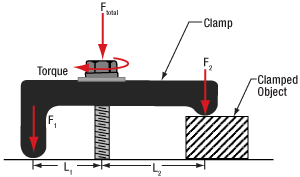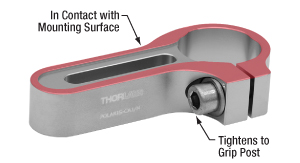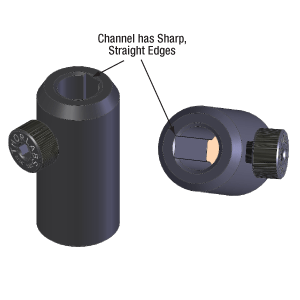Mechanical Essentials Kit: Clamping Forks and Post Holders Kit

- Kit Contains 130 Pieces
- Heavy-Duty, Welded Steel Cabinet Frame
- Cabinet Frame Can Be Wall Mounted or Stacked
- Equipped with Easy-to-Read Labels
ESK14
9 Drawers, 130 Pieces
Kit Components
See Contents Tab for Descriptions of Each Item
x10
x10
x10
x10
x10
x10
x10
x10
x15
x15
x10
x10

Please Wait

Click to Enlarge
Figure 1.2 Slots on the rear of the case allow for wall mounting.

Click to Enlarge
Figure 1.1 ESK14 shown on an RK4102 rack shelf, which is installed in an RK3884 19" rack.
Features
- Imperial and Metric Kits Contain Clamps and Universal and Pedestal Post Holders
- Frame Dimensions (L x W x H): 17" x 11" x 11" (432 mm x 279 mm x 279 mm)
- Drawer Dimensions (L x W x H): 10.56" x 5.19" x 3.06" (268 mm x 132 mm x 78 mm)
- Labels with Product Photos Facilitate the Process of Locating the Desired Part
- Increased Savings over Individual Component Products
Thorlabs' ESK14(/M) Clamping Forks and Post Holders Kit contains 130 of our most popular items in convenient, organized compartments. Included in this kit are clamping forks as well as universal and pedestal post holders for Ø1/2" posts. Each compartment is labeled with an image of the item as well as the Item #. Refer to the Contents tab for detailed information about the components included with the imperial and metric versions of this kit. This kit also includes extra dividers and white stickers to create custom labels.
Mounting Options
The kit can be placed onto a tabletop for easy, convenient access or placed on an RK4101 or RK4102 rack shelf, both of which can be installed in our RK3884 standard 19" rack. Figure 1.1 shows an ESK14 kit as well as other custom-labeled ST9 cabinets installed in a 19" rack. The cabinet used in each Essential Series Kit features slots in the rear of the case (see Figure 1.2) for wall mounting and features indentations on the top and four feet on the bottom for stable stacking. Warning: each kit weighs 40 lbs (18.1 kg); ensure that the wall and wall mounts can support at least this weight before mounting the unit.
| ESK14 Items (Imperial) |
ESK14/M Items (Metric) |
Description | Image (Click Image to Enlarge) |
Quantity |
|---|---|---|---|---|
| UPH1 | UPH30/M | Universal Post Holder with Spring-Loaded Hex Locking Thumbscrew, L = 1" (30 mm) |  |
10 |
| UPH1.5 | UPH40/M | Universal Post Holder with Spring-Loaded Hex Locking Thumbscrew, L = 1.5" (40 mm) |  |
10 |
| UPH2 | UPH50/M | Universal Post Holder with Spring-Loaded Hex Locking Thumbscrew, L = 2" (50 mm) |  |
15 |
| UPH3 | UPH75/M | Universal Post Holder with Spring-Loaded Hex Locking Thumbscrew, L = 3" (75 mm) |  |
15 |
| UPH4 | UPH100/M | Universal Post Holder with Spring-Loaded Hex Locking Thumbscrew, L = 4" (100 mm) |  |
10 |
| UPH6 | UPH150/M | Universal Post Holder with Spring-Loaded Hex Locking Thumbscrew, L = 6" (150 mm) |  |
10 |
| PH1E | PH30E/M | Pedestal Post Holder with Spring-Loaded Hex Locking Thumbscrew, L = 1.19" (34.7 mm) |  |
10 |
| PH2E | PH50E/M | Pedestal Post Holder with Spring-Loaded Hex Locking Thumbscrew, L = 2.19" (54.7 mm) |  |
10 |
| PH3E | PH75E/M | Pedestal Post Holder with Spring-Loaded Hex Locking Thumbscrew, L = 3.19" (79.7 mm) |  |
10 |
| PH4E | PH100E/M | Pedestal Post Holder with Spring-Loaded Hex Locking Thumbscrew, L = 4.19" (104.7 mm) |  |
10 |
| CF038-P5 | Clamping Fork, 0.40" Counterbored Slot, Universal |  |
2 Packs of 5 | |
| CF125-P5 | Clamping Fork, 1.24" Counterbored Slot, Universal |  |
2 Packs of 5 | |
| ST9 | 9-Drawer, Stackable Cabinet |  |
1 | |
Insights into Best Lab Practices
Scroll down to read about a few things we consider when setting up lab equipment.
- Clamping Forks: Tip for Maximizing the Holding Force
- Optical Tables: Clamping Forks and Distortion of the Table's Surface
- Post Holders: Rectangular Channel in the Inner Bore
Click here for more insights into lab practices and equipment.
Clamping Forks: Tip for Maximizing the Holding Force

Click to Enlarge
Figure 173B More than half the total applied force (FTotal) holds the object, since L1 > L2. The height of the left leg of this CL2 clamp is variable to compensate for the object's height. This allows the clamp's top surface and the mounting surface to be made parallel.**

Click to Enlarge
Figure 173A Less than half the total applied force (FTotal) holds the object, since L1 < L2. The clamp illustrated here is the CL5A.
Clamped objects can be fairly easy to move when the torqued screw in the clamp's slot is positioned too far from the object. Correct positioning of the screw protects clamped objects from being knocked out of position.
To maximize the clamping force, position the screw as close as possible to the object.**
This works since clamps like CL5A and CL2 (Figures 173A and 173B, respectively) divide the torqued screw's applied force (FTotal) between two points.
Clamping force F2 is applied to the object. The value of F2 is a percentage of FTotal and depends on L1 and L2, as described below. The remainder (F1) of the total force is applied through the opposite end of the clamp.
The following equations can be used to calculate the two applied forces.
Object: |
 |
|
| Force Applied to Other Contact Point: |
 |
These equations show that the clamping force on the object increases as the distance between the object and screw decreases. The force supplied by the torqued screw is evenly divided between F1 and F2 when L1 and L2 are equal.
**Note that maximizing the clamping force also requires both the top surface of the clamp and the area it contacts on the object to be parallel with the mounting surface, as depicted in Figures 173A and 173B.
If the tangent at the interface between the clamp and object is not parallel to the mounting surface, the force applied to the object will be divided between pressing it into and pushing it across the mounting surface. The force directed along the mounting surface may, or may not, be sufficient to translate the object.
To accommodate different object heights, clamps like the CL2 have one threaded, variable-length leg, which is shown on the left in Figure 173B. The number of threads between the clamp and mounting surface should be adjusted to compensate for the height of the object and to keep the clamp's top surface level with the table.
Date of Last Edit: Dec. 4, 2019
Optical Tables: Clamping Forks and Distortion of the Table's Surface

Click to Enlarge
Figure 173C The construction of a Nexus table / breadboard includes a (1) top skin, (2) bottom skin, (3) side finishing trim, (4) side panels, and (5) honeycomb core. The stainless steel top and bottom skins are 5 mm thick.
Clamping forks are more rigid than the mounting surface of composite optical tables. It might be expected that the spine of the clamping fork would bend with the force exerted by the screw as the torque is increased. Instead, the screw will pull the skin of the table up and out of flat before the clamping fork deforms. Due to this, clamping forks should be used with care when securing components to optical tables. Clamping arms, which are discussed in the following, are alternatives to clamping forks that are less likely to deform the table's mounting surface.
Optical Table Construction
Optical tables and breadboards with composite construction (Figure 173C) are designed to be rigid while providing vibration damping. The 5 mm thick, stainless steel top skin is manufactured to be flat, but a localized force can deform it. When the top skin is deformed, optical components will not sit flat, and optical system alignment and performance can be negatively affected.
Clamping Forks
Standard clamping forks are installed with one edge placed on the table's surface and the opposite edge on the object (Figure 173D). Between these two edges, there is clearance between the bottom of the clamp and the surface of the table. This bridge makes it possible to use a single screw to both secure the clamp to the table and exert a holding force on the object.
When the clamp is secured by torqueing the screw, the screw pulls up on the top skin of the table (Figure 173E).
As the torque on the screw increases, the top skin of the table rises. Not only does pulling up on the table surface risk permanently damaging the table, this can also disturb the alignment of the optical component the clamp is being used to secure. By lifting the table's skin, the mounting surface under the clamped object tilts.

Click to Enlarge
Figure 173F The POLARIS-CA1/M clamping arm has a slot that accepts a mounting screw, a separate screw that applies a clamping force to an installed post, and identical top and bottom surfaces. Since a nearly continuous track around the surface of the clamping arm is in contact with the mounting surface, clamping arms cause negligible bridging effects.

Click to Enlarge
Figure 173E Torqueing the screw creates a force that pulls up on the table's top skin. The lifted skin tilts the mounting surface and can induce angular deviation of the object. This effect is exaggerated in this image for illustrative purposes.

Click to Enlarge
Figure 173D A standard clamping fork, such as the CL5A, contacts the table along only one edge. The opposite edge is in contact with the object to be secured. A bridge forms between the two. The screw that applies the clamping force is not shown.
Clamping Arms
Clamping arms, such as the POLARIS-CA1/M, shown in Figure 173F, are designed to secure a post while minimally deforming the mounting surface.
The clamping arm in Figure 173F differs from clamping forks in two significant ways. One is the surface area that makes contact with the optical table, which is highlighted in red, and the other is the method used to secure the post.
The area in contact with the optical table makes a nearly continuous loop around the base of the clamp. The contact area is flat and flush with the table when the clamp is installed. The only break in the loop is a narrow slot in the vise used to grip the post.
This design uses two screws, instead of the clamping fork's single screw. One screw (not shown) secures the clamp to the table, and the other (indicated) is tightened to grip the post. Since one screw is not required to perform both tasks, it is not necessary for this clamping arm to form a bridge between the clamped object and the optical table.
Although the contact area is a loop, and not a solid surface, this clamp causes negligible distortion of the mounting surface. This is due to the open area inside the contact surface being narrow and surrounded by the sides of the clamp, which resist the force pulling up on the table.
Date of Last Edit: Dec. 4, 2019
Post Holders: Rectangular Channel in the Inner Bore

Click to Enlarge
Figure 173H Top view. The three contact locations between the post and post holder, highlighted in red, prevent the post from translating or rotating around the X or Y axes. Friction resists the post's translation and rotation around the Z axis.

Click to Enlarge
Figure 173G A channel with sharp edges is machined into the inner bore of Thorlabs' post holders.

Figure 173J A broach, such as the one illustrated here, has a row of teeth, the next taller than the previous. With the teeth in contact with the material, a machine pulls the broach across the surface. Each tooth removes a small amount of material, and the depth of the channel created by the broach equals the overall difference in tooth height.
All of Thorlabs' post holders include a channel, with straight parallel edges, running the length of the inner bore (Figure 173G). Tightening the setscrew pushes the post against the two edges of the channel (Figure 173H). Since the edges of the channel are separated by a wide distance, approximately half the inner diameter of the post holder, the seating of the post against the channel's edges is stable and repeatable.
Contact with the two edges of the channel eliminates four of the post's six degrees of freedom, since the edges block the post from translating along or rotating around either the Y or Z axis. In addition, the friction between the side of the post and the edges of the channel resists the post's movement along and around the X axis, which are the post's two remaining degrees of freedom.
Without the channel in the inner bore, there would be a single line of contact between the post and post holder. The position of the post would not be stable, since the post would be free to rotate around the Z axis and shift along the Y axis.
Even if this instability resulted in submicron-scale unwanted shifts in each component's position in an optical setup, the cumulative effect could have a significant negative impact on system performance. In addition, more frequent realignment of the system could be required.
Broaching
The channel's edges must be straight and free of bumps and roughness to hold the post stable. These post holders have straight, sharp edges when examined on a micron scale. If the edges are not completely linear, the post might rock in the holder, and / or it may not be possible to repeatably position the post in the holder.
The smooth, straight edges of the channel are achieved using a machining process called broaching. A broach (Figure 173J) resembles a saw whose teeth increase in height along its length.
As the broach is pulled along a surface, each tooth removes a small amount of material. The total depth of the channel cut by the broach equals to the overall difference in tooth height (H2 - H1).
Compared with other approaches for creating channels, broaching is preferred due to its ability to provide straight profiles while being compatible with high-volume production.
Date of Last Edit: Dec. 11, 2019
| Posted Comments: | |
| No Comments Posted |
 Products Home
Products Home












 Clamping Forks & Post Holders Kit
Clamping Forks & Post Holders Kit